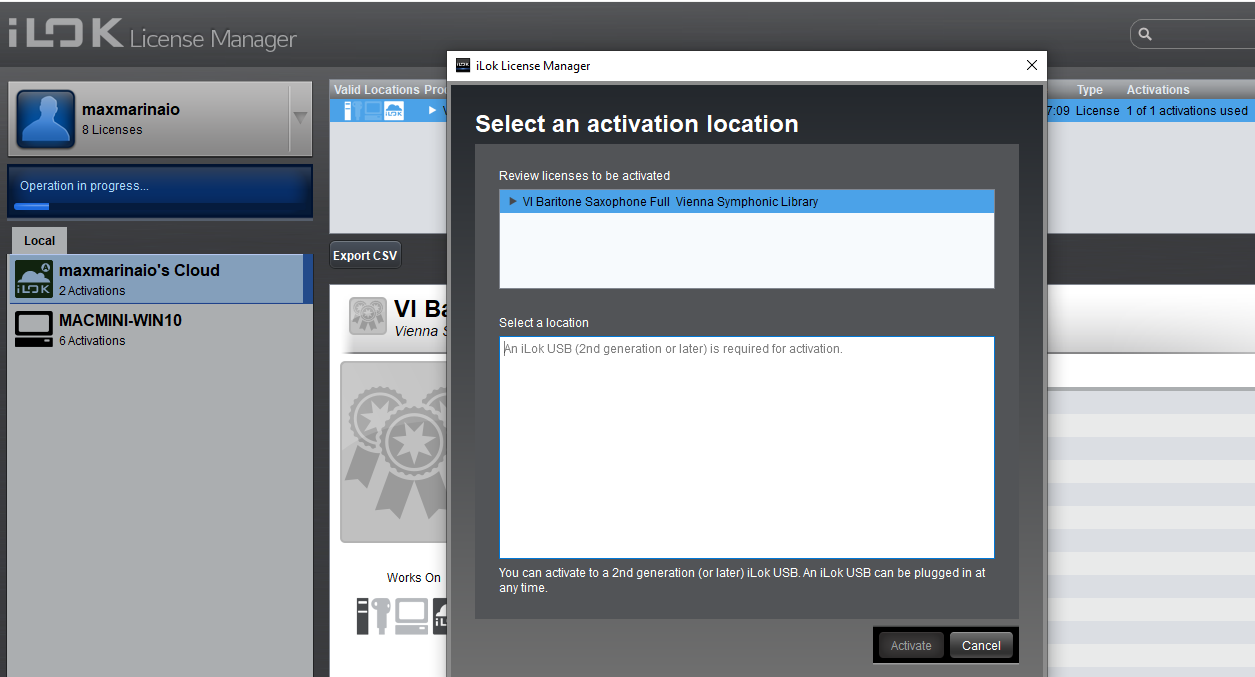@250745 said:
I'm pretty new to VSL but not to other things, and being in the middle of a production in which I needed a baritone sax I landed here and made the purchase.
So I got my baritone sax into the ilok and tried to activate it but it only activates in the cloud... ok let's do it..where is the problem?
Then I go in the Vienna Assistant and download the product convinced that I could use it with synchron... but nothing appears there if not the free instruments... mumble mumble...
so I got back to ilok and... well actually the sax in not activated it tells me that I need a 2d generation usb to sctivate!
What? Will I need a usb key to use this product??? When Mr Kopf is assuring everybody everywhere we don't need that?
And for what I understand even if I will manage to activate the sax I will have to use a different player... ? The vienna instrument I suppose
Contacted the support and all they do is asking if I'm logged in my cloud... yes boys I'm logged in ilok, cloud, VSL website and everywhere I need to be logged! I added screenshot in the mail. Now I'm still waiting to understand if and how will I be able to use this product... and begin to be little bored... because...
notice: in this page: https://www.vsl.co.at/en/Saxophones/Baritone_saxophone#!System_Requirements
there is not a single word about all these problems... you can have, no exact player is indicated, no mention it is not a synchron player instrument
and there is no mention about this is an instrument that differently from others need a cloud activation which is ok but... even an usb hardware key??? Hope somebody have the solution here.
So guys at least I'm expectig to activate this thing with no USB keys otherwise I'd prefer a refund.... and retrietment
what am I supposed to do with an obsolete instrument?
To respond to your point that it is apparently not stated anywhere that the baritone saxophone (only) runs in the Vienna Instruments Pro sampler, I would like to briefly explain the VSL system to you.
The reasons why this is the case are obvious:
Firstly, most of VSL's customers are long-time customers and had already purchased from them before the Synchron Player and corresponding libraries existed and Vienna Instruments (Pro) was the only sampler available and so they know which product is for which sampler.
Secondly, most new customers look very carefully at the libraries and their developers before they buy the products so as not to buy a pig in a poke.
Thirdly, it is stated, or not stated, which sampler is required. This is where VSL's naming system comes into play: all libraries developed for the Synchron Player have "Synchron" in their name; all libraries converted for the Synchron Player have "SYNCHRON-ized" in their name. The "old", dry libraries that were developed for Vienna Instruments Pro have no such designations in their names. A further indication of which sampler the libraries are for can be found in the organisation system/"file path", which is indicated directly above the product. ("VI Series" requires Vienna Instruments [Pro].)
 Fourthly, for the libraries that run in a dedicated sampler of their own, this is specifically indicated in the product description, because they are nevertheless part of the "Synchron" or "VI Series" product ranges, they fall into their naming system, which is why it is specifically indicated that they run in their own software. These sample libraries include the Synchron Pianos, Synchron Harp and the Great Rieger Organ.
Fourthly, for the libraries that run in a dedicated sampler of their own, this is specifically indicated in the product description, because they are nevertheless part of the "Synchron" or "VI Series" product ranges, they fall into their naming system, which is why it is specifically indicated that they run in their own software. These sample libraries include the Synchron Pianos, Synchron Harp and the Great Rieger Organ.
In general, I would like to explain what the big difference between the two product lines is: the instruments and ensembles of the Synchron Series are recorded with several microphone positions in a non-dry recording room called Synchron Stage A, sometimes also in the smaller, drier Synchron Stage B. The VI Series libraries come with only one microphone position and are recorded in the dry Silent Stage. The converted VI Libraries, which then have "SYNCHRON-ized" in their name, are provided with an impulse response from Synchron Stage A in their typical position in the orchestra, which can be switched on and off (or bypassed). This makes them sound as if they had been recorded there.
From your post, I can only guess that you bought the baritone saxophone almost blindly and in a hurry, without first familiarising yourself with VSL, its concept(s) and libraries in general, which you should do, no matter which developer it is. If you had, you wouldn't have written this almost angry-looking post. Before one goes off on someone indignantly, one should first check whether the mistakes are possibly one's own and whether one hasn't overlooked something.

